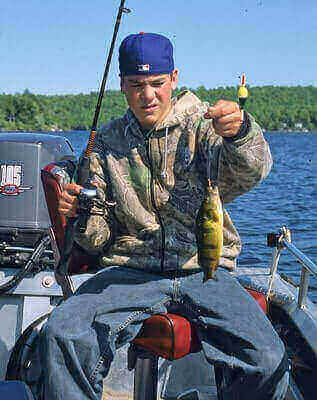Disclosure: We may earn commissions if you purchase products after clicking on a link from our site.
Do you want to learn how to catch more perch? Are you looking for information to help you be more successful fishing for perch? Perch are abundant, feed all year, and are tasty. In this article, we share perch fishing tips to help you catch more perch and enjoy the year-round fishing of perch.
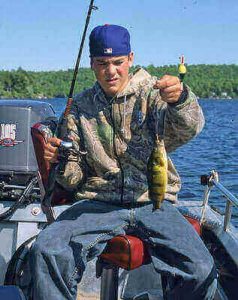
Table of Contents
- 1 How To Catch Perch
- 2 Perch Fishing For Beginners
- 3 Perch Fishing Setup
- 4 How To Catch Perch From Shore
- 5 How To Catch Perch In Summer
- 6 How To Catch Perch In Michigan
- 7 How To Catch Perch In Winter
- 8 Perch Fishing Tips
- 9 Perch Fishing Gear
- 10 Perch Ice Fishing
- 11 Best Live Bait For Perch
- 12 Best Lures And Jigs For Perch
- 13 The Bottom Line
How To Catch Perch
1. Trolling
Trolling is a popular and effective fishing method employed by anglers to target perch, prized freshwater fish known for their tasty flesh and widespread distribution in lakes and rivers. This technique involves trailing one or more lines behind a moving boat while covering a large area of water.
Anglers typically use trolling rigs equipped with small spoons, spinners, or crankbaits, designed to imitate the natural prey of perch. By adjusting the speed and depth of the trolling presentation, anglers can effectively target perch at various depths and in different areas of the water body.
Trolling allows anglers to explore vast stretches of water and locate schools of perch, often found near drop-offs, submerged structures, or weed beds. With its versatility and ability to cover a wide range of depths and areas, trolling remains a favored method for anglers seeking to catch perch, promising an exhilarating and rewarding fishing experience on the water.
2. Baitcasting
Baitcasting is a specialized fishing technique that can be highly effective for targeting perch, prized freshwater fish known for their delicious taste and widespread presence in lakes and rivers. This method involves using a baitcasting reel mounted on a baitcasting rod, allowing anglers to cast with precision and accuracy.
Anglers typically employ small jigs, spinners, or crankbaits as lures, choosing colors and sizes to match the preferences of perch in different conditions. By casting near submerged structures, weed beds, or drop-offs where perch are known to congregate, anglers can entice strikes from these fish.
Baitcasting offers anglers the ability to control the presentation of the lure with precision, allowing for targeted retrieves and accurate placement of the bait. With its versatility and effectiveness in targeting perch in various environments, baitcasting remains a favored method among anglers seeking a thrilling and productive day on the water.
3. Still fishing
Still fishing, also known as stationary fishing, is a straightforward yet effective method often employed by anglers to catch perch, prized freshwater fish known for their delicious taste and widespread distribution in lakes and rivers. This technique involves baiting a hook with live bait such as worms, minnows, or insect larvae and casting it into the water, allowing it to remain stationary until a perch bites.
Anglers typically target areas near submerged structures, weed beds, or drop-offs where perch are known to congregate. With patience and keen observation, anglers can detect subtle bites and strikes from perch, resulting in successful hooksets. Still fishing offers anglers a relaxed and leisurely approach to fishing while providing ample opportunities to catch perch and enjoy a rewarding day on the water.
4. Ice fishing
You can fish for perch year round including the winter. Perch is a schooling fish and tend to bite in cold water making it easy to catch a lot of them during the winter. Ice fishing is a popular and effective method for targeting perch, prized freshwater fish known for their delicious taste and widespread presence in lakes and rivers.
This technique involves drilling a hole through the thick layer of ice covering the water surface and dropping a line with bait or lures into the icy depths below. Anglers typically use small jigs, spoons, or live bait such as minnows or worms to entice perch into biting. Ice fishing requires patience and skill, as anglers must wait patiently for perch to detect their bait and strike.
Anglers often employ specialized equipment such as ice fishing rods, tip-ups, and portable shelters to stay warm and comfortable while waiting for bites. With its unique challenges and exhilarating experience of fishing in the frozen landscape, ice fishing provides anglers with a thrilling and rewarding opportunity to catch perch during the winter months.
5. Vertical Jigging
Vertical jigging is a highly effective and versatile fishing technique used by anglers to target perch, prized freshwater fish known for their delicious taste and widespread distribution in lakes and rivers. This method involves dropping a jigging lure vertically beneath the boat and imparting subtle or erratic movements to mimic the behavior of prey.
Anglers typically use small jigs or spoons in various colors and sizes to match the preferences of perch in different conditions. By adjusting the speed and intensity of the jigging motion, anglers can entice strikes from perch, particularly when fishing near submerged structures, weed beds, or drop-offs where perch are known to congregate.
Vertical jigging requires finesse and precision, as anglers must carefully control the presentation of the lure to attract bites. With its effectiveness in targeting perch at various depths and in different environments, vertical jigging remains a favored method among anglers seeking a thrilling and productive day on the water.
Perch Fishing For Beginners
As a beginner, you can fish on a boat with others to give you some guidance or you can fish from the shoreline, piers, or docks. There are several fishing methods that you can use to fish for perch as a beginner. You can implement bait casting, still fishing, or drifting along the shoreline.
Fishing piers and docks are especially some of the best yellow perch fishing spots during warm months. If your favorite lake has one, pick a comfortable sitting spot, bait a lightly weighted hook with a small live minnow, release the bait to the bottom, and then relax until a perch bites. Most times, that’s all it takes.
Perch Fishing Setup
Perch is not a large fish and when fishing for it, you will need a light fishing rod and reel, preferably about 6 feet or more, with a 4 to 8-pound test line. Monofilament lines are the popular choice for lines. Hooks in the range from 4 to 8 will work for most of the baits used for perch.
How To Catch Perch From Shore
Perch is one of the most sought-after fish in North America. They are small but fight hard when caught. Perch’s behavior changes during each season, and this makes you alter slightly your fishing strategies when fishing for perch from the shore.
Perch will move to deeper waters during the winter, therefore you want to get your live bait as close as possible to the bottom to get them. Additionally, if you use lures, cast the lure at 45 degrees and reel slowly.
In spring, especially early spring, perch will be found within 50 feet of shore. Cast your baits in this range and fish slowly. Later in spring, you will find perch in medium-depth water near docks, weeds, and shelves. Cast within 50 feet of the shore with baits and lures.
During summer, you will find perch around covers like docks, lily pads, logs, wrecks, and other structures. Fish these areas for perch. Get your bait down to target large perch. Additionally, look for areas with shade where perch may seek refuge from the sun. Target those areas with your baits and lures. Baitcasting, trolling, and drifting are used to catch perch from the shore.
How To Catch Perch In Summer
During the summer look for structures that perch will use as cover to hide from prey and protect themselves from predators. Docks, wrecks, rocks, and ledges are some of the structures to target. Additionally, look for areas that have shade from the sun. Perch and other marine life will be in shaded areas away from the sun’s rays.
Cast your bait near these areas when fishing for perch in summer. Casting, trolling, drift fishing, and still fishing are some of the fishing methods used when fishing for perch in summer.
In fall, perch will begin moving from shallow to deeper water. They will be around covered in 10-20 feet of water. Docks, piers, rocks, and other structures will be good areas to target. They will be about 50 feet from the shore which still makes it possible to cast from the shore. If you are not on the backs, you can troll or drift for perch.
How To Catch Perch In Michigan
Perch is the most frequently caught game fish in Michigan. They can be found in shallow waters near the shore. You will find them in waters about 30 feet deep. The best time to catch them is early morning and evening when they move towards the shore to feed. Use baits and lures to catch perch. Casting is the popular fishing method when targeting them.
How To Catch Perch In Winter
During winter perch will move to deeper water columns in the range from 8-15 feet. They will be about 100 feet from the shore. Bottom fishing is the fishing method to use as you want to target them where they have moved to.
Live bait works well, but minnows, nightcrawlers, and mealworms also work. You can also use lures. Jigging is also another fishing method that works during the winter.
Perch Fishing Tips
1. Fish for perch on the bottom as they feed on the bottom. Although they feed on the bottom, they will rise if there is a lot of food above.
2. During the warm months, perch likes to linger around fishing piers and docks. If you have some of these structures nearby, fish there as they are some of the best fishing spots.
3. Perch cannot resist tiny bits of live bait like small strips of belly meat, chunks of cut-up minnow, or parts of a fish like an eyeball. Put small pieces of live bait on a plain hook or use it to tip a little spoon or jig
4. In spring when fishing for perch, you should always be on the move. Perch are schooling fish and you will find them in one spot one week and in another spot the next week.
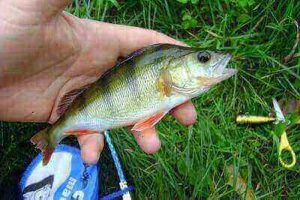
5. Spots inshore near shallow breaks or in water to the depth of 30 ft/9 m can also be good spots to find perch. They also gather near rocks, weed beds, reeds, or channels. Check such structures for perch.
6. In deeper lakes perch are found around islands, rocky shoals, and points. Find a soft mud bottom as they are full of invertebrates like midge larvae and fingernail clams to attract perch.
7. When you finally locate a school of perch, fishing might start slow. But when you start catching perch, things might ramp up so quickly that it might end up being a feeding frenzy. Step up your speed and land fish quickly and get your bait or lure back in the water fast because another perch might bite right away.
8. When the water starts to cool, the bigger perch will go deeper into the water and remain there during the winter. They school together and remain under the ice. Ice fishermen should not fish too shallow or you will miss the bigger perch.
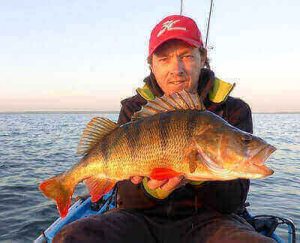
9. Whenever you find spots that are a mixture of aquatic vegetation, gravel, and rocks, you just might find perch around. Drop-offs and shallow reefs surrounded by deeper water are also good places for perch.
10. Any river that has a good population of walleye will also have perch.
11. Large, slow-moving rivers are also good spots for perch. They can also be found in small rivers and streams that are also slow-moving.
12. When the current isn’t strong, you will find perch in deep holes and pools.
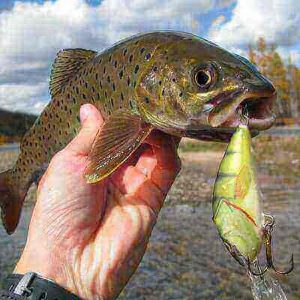
13. The best times of the day to be on the water fishing for perch are in the morning and evening when they are very active.
14. Perch like mild and stable temperatures, clouds, drizzles, and southern or western winds. They don’t like weather conditions that are usually associated with high-pressure systems like clear skies, bright sunlight, northern or eastern winds, or big temperature changes between night and day.
15. Overhanging trees or bushes not only protect perch from their prey, but it also serve as a food source. Insects and smaller fish are often found there that are food for perch. If you find large trees hanging over creeks or other bodies of water, you might find perch there.
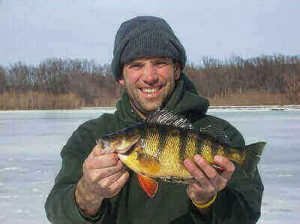
16. If you spot splashing prey fish on the water surface, chances are they are being rounded up by perch.
17. One of the perchs’ hunting tactics is to hunt in packs and push the prey upward toward the surface where their escape route is cut off. Cast your bait on the water surface if you spot activity of this nature.
18. During the winter, use slow retrievable baits on or just off the bottom for perch. Baits such as soft baits such as shads, creature baits, or curly tails.
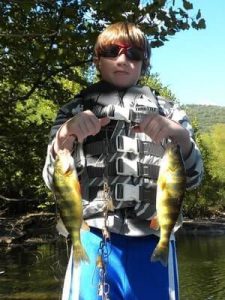
19. Fishing at night for perch is not popular with many perch anglers, but it can prove to be very rewarding. The bigger perch are more active in hunting when it is dark.
20. Perch are most active when feeding. This fact alone can help you catch a lot of perch if you are prepared for their activity. The right time of the day really depends on the season you are fishing. Early morning and early evening are the best time of the day during late spring and early summer.
During late summer, late afternoon and evening are the best. The best time in autumn is the morning and late evening. In winter, the late afternoon is the best time.
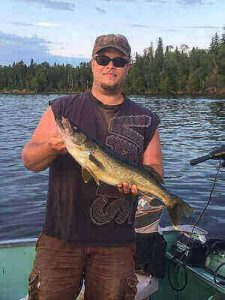
21. Perch is most active in the early morning and late evening.
22. Perch likes mild and stable temperatures, clouds, drizzles, and western or southern winds.
23. Perch doesn’t like clear skies and bright sunlight, big temperature changes, and northern or eastern winds.
24. Look for perch under overhanging trees and bushes as they provide cover from predators and also serve as a cover for perch to ambush its prey.
25. Fish for perch in weeds and reeds. They also provide cover from predators and cover to ambush their prey.
26. Scan the water surface for splashing prey fish.
27. One of perch’s hunting tactics is to attack its prey from below and push them to the surface. Perch hunt in packs and if you see a lot of splashing and baitfish activity on the surface, most likely it is caused by perch preying on baitfish. Fish that area for perch.
28. When the water is warm in the summer, perch are more active and alter your strategy to use faster lures. Use spinners and crankbaits.
29. During the winter months, use slow retrievable baits.
30. Live bait is the best bait for perch fishing.
31. The bait should not be too big or it might not fit into the mouth of the perch. Bait sizes of 2 to 5 inches are the right size for perch.
32. Use maggot as bait on a maggot feeder rig at the bottom to catch perch.
33. Don’t use maggots to fish for perch in areas that contain a lot of small fish as they will eat all of the maggots.
34. Fish for perch at night using bait or lures. When using lures, use bright colors.
35. Perch can also be found around structures like pilings, weed beds, brushes, and fallen trees.
36. Perch is a schooling fish that provides some kind of safety. They are often found in schools of 50 to 200 fish.
37. During warm weather, you can fish for perch around docks and piers.
38. Bait casting, trolling, still fishing, and ice fishing are fishing methods you can use to catch perch.
39. Perch spawn in the spring in shallow waters when the temperature is around 50 degrees.
40. Perch are poor swimmers and this makes them a target for other big fish.
41. Perch goes crazy for cut baits of other perch. Use a perch you caught, cut it into pieces, and use it as bait.
42. Use the eyes from the perch you cut into pieces as bait and put the eye on the hook as bait. It works.
43. When you are fishing for jumbos, don’t anchor the boat. Instead, let it drift to cover more area.
44. Use chumming to attract perch closer to you.
45. When the water that you are fishing for perch is shallower than 15 feet, you can use the boat’s motor to make some noise that may attract curious perch that will come to find out what is making the noise.
46. The drop shot rig can be very productive in catching many perch.
47. When you are fishing in the deep waters, one trick is to put some glow on your line that can attract perch to it and get hooked up.
48. Fish have a habit of being found in the same spots time and time again. When you find perch in one area, you can mark a waypoint on the GPS. Each time you find a school of perch, mark a waypoint. You will realize over time that the fish tend to be in the same area often.
59. Invest in a good fish finder if you don’t have one.
50. Perch is often found near the bottom. Always keep your bait about 1 to 2 feet from the bottom to catch perch.
Perch Fishing Gear
1. Rods & Reels
Fishing rods and reels are essential gear for anglers targeting perch, prized freshwater fish known for their delicious taste and widespread distribution in lakes and rivers. When fishing for perch, anglers typically use lightweight spinning or baitcasting rods paired with quality reels equipped with smooth drag systems.
These rods provide the necessary sensitivity to detect subtle bites from perch while also offering the strength and durability to handle their spirited fights. Anglers often spool their reels with monofilament, fluorocarbon, or braided fishing lines, depending on personal preference and fishing conditions.
Additionally, the versatility of fishing rods and reels allows anglers to employ various techniques such as casting, jigging, or trolling when targeting perch in different environments and water depths. With their reliability and effectiveness in handling the unique challenges of perch fishing, fishing rods, and reels remain indispensable tools for anglers seeking a thrilling and productive day on the water.
2. Hooks
Hooks are fundamental fishing gear for anglers targeting perch, prized freshwater fish known for their delicious taste and widespread presence in lakes and rivers. When fishing for perch, anglers typically use small to medium-sized hooks, ranging from #6 to #10 in size, depending on the bait or lure being used and the size of the perch being targeted.
Hooks may be rigged with live bait such as worms, minnows, or insect larvae, or used to secure artificial lures like jigs or spinners. Sharp and sturdy hooks are essential for effectively hooking and landing perch, as these fish can exhibit subtle bites and strong runs.
Anglers may also opt for specialized hooks such as treble hooks or circle hooks when targeting perch in specific environments or using particular techniques. With their reliability and importance in securing a successful catch, hooks remain a fundamental component of the fishing gear arsenal for anglers pursuing perch, ensuring an enjoyable and rewarding fishing experience on the water.
3. Line
Fishing lines play a crucial role in the gear arsenal of anglers targeting perch, esteemed freshwater fish known for their delicious taste and widespread presence in lakes and rivers. When fishing for perch, anglers typically opt for monofilament, fluorocarbon, or braided fishing lines, selecting line weights and strengths based on personal preference and fishing conditions.
Monofilament lines offer stretch and forgiveness, which can be advantageous when fighting perch, while fluorocarbon lines provide low visibility and abrasion resistance, ideal for fishing in clear water or around rocky structures. Braided lines offer superior sensitivity and strength, allowing anglers to detect subtle bites and handle the powerful runs of perch.
Additionally, anglers may use leaders or line weights to adjust the presentation depth when targeting perch in different water depths and currents. With their versatility and reliability, fishing lines are essential components of the gear setup for anglers pursuing perch, ensuring an enjoyable and successful fishing experience on the water.
Perch Ice Fishing
Perch are a schooling fish and because they tend to bite in cold water, they are an easy target for ice fishermen. Don’t be surprised when you catch a bunch of perch during the winter months on the ice. An ultralight spinning rod spooled with a 4-pound line is a good choice for ice fishing perch.
Using tip-ups that allow you to set the depth and send the live bait down is the common method of ice fishing for perch. You can also use a jig if you have a pretty good idea of where the school is located.
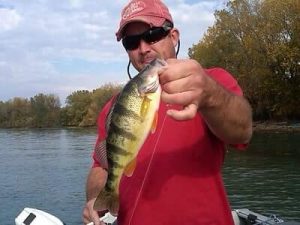
Best Live Bait For Perch
1. Minnows
Minnows serve as a highly effective and versatile bait option for anglers targeting perch, esteemed freshwater fish known for their delicious taste and widespread distribution in lakes and rivers. These small fish emit a natural scent and possess lively swimming motions, making them irresistible to perch.
Anglers typically rig minnows on hooks or jigheads and present them near submerged structures, weed beds, or drop-offs where perch are known to congregate. Whether fished beneath a float or slowly retrieved along the bottom, minnows offer versatility and effectiveness in enticing perch into striking.
With their availability at bait shops and proven success in attracting perch, minnows provide anglers with a reliable and rewarding option for pursuing these prized freshwater fish, ensuring an enjoyable and productive fishing experience on the water.
2. Leeches
Leeches are an effective and often overlooked bait option for anglers targeting perch, esteemed freshwater fish known for their delicious taste and widespread presence in lakes and rivers. These aquatic invertebrates emit a natural scent and exhibit subtle movements that entice perch to strike.
Anglers typically rig leeches on small hooks or jigheads and present them near submerged structures, weed beds, or drop-offs where perch are known to congregate. The undulating movement of the leech, combined with its enticing scent, provokes aggressive strikes from perch, making them a favored bait choice.
Whether fished beneath a float or slowly drifted along the bottom, leeches offer versatility and effectiveness in enticing perch into biting. While not as readily available as other baits, leeches provide anglers with a unique and productive option for pursuing these prized freshwater fish, ensuring an enjoyable and rewarding fishing experience on the water.
3. Redworms
Red worms, also known as red wigglers, are a popular and effective bait choice for anglers targeting perch, esteemed freshwater fish known for their delicious taste and widespread presence in lakes and rivers. These small worms emit a natural scent and possess lively movements that attract perch to strike.
Anglers typically rig red worms on small hooks or jigheads and present them near submerged structures, weed beds, or drop-offs where perch are known to congregate. The wriggling action of the red worms, combined with their enticing scent, provokes aggressive strikes from perch, making them a favored bait choice.
Whether fished beneath a float or slowly retrieved along the bottom, red worms offer versatility and effectiveness in enticing perch into biting. With their availability at bait shops and proven success in attracting perch, red worms provide anglers with a reliable and rewarding option for pursuing these prized freshwater fish, ensuring an enjoyable and productive fishing experience on the water.
4. Crickets
Crickets, with their lively movements and distinctive chirping, are an effective and versatile bait option for anglers targeting perch, esteemed freshwater fish known for their delicious taste and widespread presence in lakes and rivers. These small insects emit a natural scent and exhibit erratic movement that entices perch to strike.
Anglers typically rig crickets on small hooks or jigheads and present them near submerged structures, weed beds, or drop-offs where perch are known to congregate. The lively action of the cricket, combined with its enticing scent, provokes aggressive strikes from perch, making them a favored bait choice.
Whether fished beneath a float or slowly retrieved along the bottom, crickets offer versatility and effectiveness in enticing perch into biting. With their availability at bait shops and proven success in attracting perch, crickets provide anglers with a reliable and rewarding option for pursuing these prized freshwater fish, ensuring an enjoyable and productive fishing experience on the water.
5. Small Crayfish
Small crayfish, also known as crawfish or crawdads, can be an effective and natural bait choice for anglers targeting perch, esteemed freshwater fish known for their delicious taste and widespread presence in lakes and rivers. These crustaceans emit a distinct scent and exhibit lively movements that attract perch to strike.
Anglers typically rig small crayfish on hooks or jigheads and present them near submerged structures, weed beds, or drop-offs where perch are known to congregate. The lifelike motion and enticing aroma of the crayfish provoke aggressive strikes from perch, making them a favored bait option. Whether fished on the bottom or suspended beneath a float, small crayfish offer versatility and effectiveness in enticing perch into biting.
With their availability in freshwater habitats and proven success in attracting perch, small crayfish provide anglers with a natural and rewarding option for pursuing these prized fish, ensuring an enjoyable and productive fishing experience on the water.
6. Waxworms
Waxworms are a highly effective and versatile bait option for anglers targeting perch, esteemed freshwater fish known for their delicious taste and widespread presence in lakes and rivers. These small, creamy-white larvae emit a natural scent and possess lively movements that entice perch to strike.
Anglers typically rig waxworms on small hooks or jigheads and present them near submerged structures, weed beds, or drop-offs where perch are known to congregate. The wriggling action and enticing aroma of the waxworms provoke aggressive strikes from perch, making them a favored bait choice. Whether fished beneath a float or slowly retrieved along the bottom, waxworms offer versatility and effectiveness in enticing perch into biting.
With their availability at bait shops and proven success in attracting perch, waxworms provide anglers with a reliable and rewarding option for pursuing these prized freshwater fish, ensuring an enjoyable and productive fishing experience on the water.
7. Mayfly Larvae
Mayfly larvae, also known as nymphs, are a natural and effective bait choice for anglers targeting perch, esteemed freshwater fish known for their delicious taste and widespread presence in lakes and rivers. These aquatic insects emit a natural scent and possess a soft, wriggling body that entices perch to strike.
Anglers typically rig mayfly larvae on small hooks or jigheads and present them near submerged structures, weed beds, or drop-offs where perch are known to congregate. The lifelike motion and enticing aroma of the mayfly larvae provoke aggressive strikes from perch, making them a favored bait option.
Whether fished on the bottom or suspended beneath a float, mayfly larvae offer versatility and effectiveness in enticing perch into biting. With their availability in freshwater habitats and proven success in attracting perch, mayfly larvae provide anglers with a natural and rewarding option for pursuing these prized fish, ensuring an enjoyable and productive fishing experience on the water.
8. Maggots
Maggots, the larval stage of flies, are a popular and effective bait choice for anglers targeting perch, esteemed freshwater fish known for their delicious taste and widespread presence in lakes and rivers. These small, soft-bodied larvae emit a natural scent and possess subtle movements that entice perch to strike.
Anglers typically rig maggots on small hooks or jigheads and present them near submerged structures, weed beds, or drop-offs where perch are known to congregate. The wriggling action and enticing aroma of the maggots provoke aggressive strikes from perch, making them a favored bait option.
Whether fished beneath a float or slowly retrieved along the bottom, maggots offer versatility and effectiveness in enticing perch into biting. With their availability at bait shops and proven success in attracting perch, maggots provide anglers with a reliable and rewarding option for pursuing these prized freshwater fish, ensuring an enjoyable and productive fishing experience on the water.
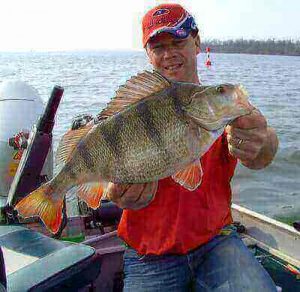
Best Lures And Jigs For Perch
1. Small Jigs
Small jigs are highly effective and versatile lures for anglers targeting perch, esteemed freshwater fish known for their delicious taste and widespread presence in lakes and rivers. These compact lures typically consist of a weighted head adorned with a soft plastic body or feather tail, designed to mimic the appearance and movement of natural prey.
Anglers can choose from a wide range of jig colors, sizes, and styles to match the preferences of perch in different conditions. Small jigs are typically fished by casting and retrieving or vertically jigging near submerged structures, weed beds, or drop-offs where perch are known to congregate.
The lifelike action and realistic presentation of small jigs make them highly effective in enticing perch to strike. With their versatility and proven effectiveness, small jigs are a go-to lure choice for anglers pursuing perch, promising an exhilarating and rewarding fishing experience on the water.
2. Spinners
Spinners are versatile and effective lures for anglers targeting perch, esteemed freshwater fish known for their delicious taste and widespread presence in lakes and rivers. These lures typically consist of a metal blade or blades that spin around a central shaft, creating vibrations and flashes that mimic the movement of small prey fish.
Anglers can choose from a variety of spinner sizes, colors, and blade designs to match the preferences of perch in different conditions. Spinners are typically fished by casting and retrieving near submerged structures, weed beds, or drop-offs where perch are known to congregate.
The enticing movement and flashy appearance of spinners make them highly effective in attracting perch to strike. With their versatility and proven effectiveness, spinners are a favored lure choice for anglers pursuing perch, promising an exhilarating and rewarding fishing experience on the water.
3. Jigging Spoons
Jigging spoons are popular and effective lures for anglers targeting perch, esteemed freshwater fish known for their delicious taste and widespread presence in lakes and rivers. These lures typically consist of a metal spoon-shaped body with a single or treble hook attached.
Anglers can choose from a variety of sizes and colors to match the preferences of perch in different conditions. Jigging spoons are typically fished by dropping them vertically beneath the boat and imparting an erratic jigging motion to mimic the movement of injured baitfish.
They are effective when targeting perch near submerged structures, weed beds, or drop-offs where perch are known to congregate. The fluttering action and flash of jigging spoons make them highly enticing to perch, often resulting in aggressive strikes. With their versatility and proven effectiveness, jigging spoons are a favored lure choice for anglers pursuing perch, promising an exhilarating and rewarding fishing experience on the water.
4. Crankbaits
Crankbaits are versatile and effective lures for anglers targeting perch, esteemed freshwater fish known for their delicious taste and widespread presence in lakes and rivers. These lures typically consist of a hard-bodied design with a diving lip that allows them to dive to specific depths in the water column, making them ideal for targeting perch holding near submerged structures, weed beds, or drop-offs.
Anglers can choose from a variety of sizes, colors, and diving depths to match the preferences of perch in different conditions. Crankbaits are typically fished by casting and retrieving, allowing them to imitate the movements of injured baitfish. The lifelike action and realistic appearance of crankbaits make them highly enticing to perch, often resulting in aggressive strikes. With their versatility and proven effectiveness, crankbaits are a favored lure choice for anglers pursuing perch, promising an exhilarating and rewarding fishing experience on the water.
5. Bobbers
Bobbers, also known as floats, can be used effectively as part of a perch angler’s arsenal, though they are not technically lures themselves. When rigged with bait such as worms, minnows, or small jigs, bobbers serve as visual indicators of bites, helping anglers detect subtle strikes from perch.
By adjusting the depth at which the bait is presented below the bobber, anglers can target perch at various water depths, including near the surface or suspended above submerged structures. Bobbers are particularly useful for beginners or those fishing in areas with dense vegetation or obstacles, as they help prevent snagging and provide a clear indication of when a perch has taken the bait.
With their simplicity and effectiveness in enhancing bait presentation and bite detection, bobbers remain a valuable tool for anglers pursuing perch, ensuring an enjoyable and productive fishing experience on the water.
The Bottom Line
Perch feed all year round and with the knowledge and skills, you can catch perch all year. They are abundant and quick to bite. They are also hard-fighting and tasty. Perch is a favorite of anglers and in this article, we share perch fishing tips gathered from years of fishing these little panfishes.
We hope you will use some of these fishing tips to catch and take more perch home whether you are a beginner or an experienced angler. If you also fish for trout, then this article about trout fishing tips for beginners will help you learn how to catch more trout. If you are also interested in other fish like wahoo, amberjack, and Mahi Mahi, then read how to catch wahoo, how to catch amberjack, how to catch yellow perch, and how to catch Mahi Mahi.
